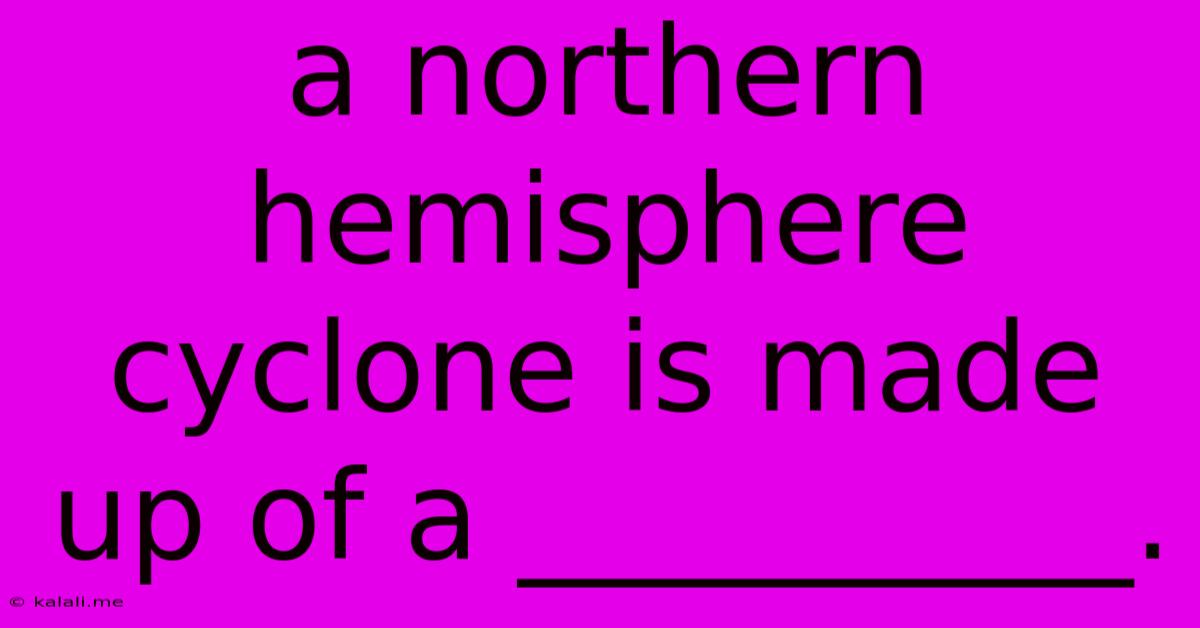A Northern Hemisphere Cyclone Is Made Up Of A __________.
Kalali
May 10, 2025 · 3 min read

Table of Contents
A Northern Hemisphere Cyclone is Made Up of a Counter-Clockwise Rotating Air Mass
A northern hemisphere cyclone is characterized by a counter-clockwise rotating air mass spiraling inwards towards a low-pressure center. This fundamental characteristic is dictated by the Coriolis effect, a phenomenon resulting from the Earth's rotation. Understanding this fundamental structure is key to predicting its behavior and potential impacts. This article will delve deeper into the composition and dynamics of these impactful weather systems.
Understanding the Coriolis Effect and Cyclone Formation:
The Coriolis effect deflects moving objects (including air masses) to the right in the Northern Hemisphere and to the left in the Southern Hemisphere. As air rushes towards the low-pressure center of a cyclone, this deflection creates the characteristic rotating pattern. The air doesn't simply move straight in; it's constantly being nudged sideways, resulting in the spiral. This inward spiraling motion is crucial for the cyclone's energy and intensity.
Components of a Northern Hemisphere Cyclone:
A northern hemisphere cyclone isn't just a simple rotating mass of air. It's a complex system with several key components:
-
Low-Pressure Center (Eye): At the heart of the cyclone lies an area of significantly lower atmospheric pressure than the surrounding environment. This pressure differential is the driving force behind the entire system. The eye is often relatively calm compared to the surrounding storm.
-
Spiral Rainbands: Surrounding the eye are bands of intense thunderstorms and heavy precipitation. These bands spiral inward towards the center, fueled by the rising warm, moist air. The strength and intensity of these rainbands are directly related to the cyclone's overall power. These rainbands often contain the strongest winds and heaviest rainfall associated with the cyclone.
-
Warm Front and Cold Front: Cyclones frequently incorporate warm and cold fronts. A warm front is where warmer air rises over cooler air, often leading to widespread, but less intense precipitation. A cold front, where colder, denser air pushes under warmer air, is associated with more intense, shorter-lived precipitation and often stronger wind gusts. The interaction between these fronts is critical in the cyclone's evolution and intensification.
-
Eye Wall: Immediately surrounding the eye is the eye wall, a region of extremely strong winds and intense rainfall. The eye wall is responsible for the most destructive aspects of a cyclone, with wind speeds often exceeding 100 mph (160 km/h) in severe cases.
-
Upper-Level Divergence: While the inward spiraling motion near the surface is crucial, the cyclone's upper levels play a vital role. Divergence aloft, where air spreads outwards, is essential for maintaining the low pressure at the surface and allowing the upward motion of air which fuels the storm. Without upper-level divergence, the storm would quickly weaken.
Factors Influencing Cyclone Intensity:
The intensity of a northern hemisphere cyclone is influenced by a number of factors, including:
-
Sea Surface Temperature: Warmer ocean waters provide the energy needed for cyclone development and intensification. The warmer the water, the greater the potential for a powerful storm.
-
Atmospheric Instability: Instability in the atmosphere, characterized by a steep temperature gradient between the surface and upper levels, is crucial for the development of strong updrafts that fuel the cyclone.
-
Wind Shear: Wind shear, the change in wind speed or direction with altitude, can weaken or disrupt a cyclone. Low wind shear is generally favorable for cyclone development and intensification.
-
Latitude: Cyclones typically form in specific latitude ranges where the Coriolis effect is strong enough to initiate rotation but not so strong as to inhibit formation.
In conclusion, a northern hemisphere cyclone is a complex and dynamic weather system characterized by its counter-clockwise rotating air mass spiraling inwards towards a low-pressure center. Understanding its components, dynamics, and influencing factors is crucial for accurate forecasting and effective disaster preparedness. Continued research and advancements in weather forecasting technology are essential for improving our ability to predict and mitigate the impact of these powerful storms.
Latest Posts
Latest Posts
-
Jaguar Adaptations In The Tropical Rainforest
May 10, 2025
-
How To Find Average Velocity From Velocity Time Graph
May 10, 2025
-
What Is Non Living Things In The Ecosystem
May 10, 2025
-
How Many Fl Oz In 6 Cups
May 10, 2025
-
What Is 1 Percent Of 5000
May 10, 2025
Related Post
Thank you for visiting our website which covers about A Northern Hemisphere Cyclone Is Made Up Of A __________. . We hope the information provided has been useful to you. Feel free to contact us if you have any questions or need further assistance. See you next time and don't miss to bookmark.